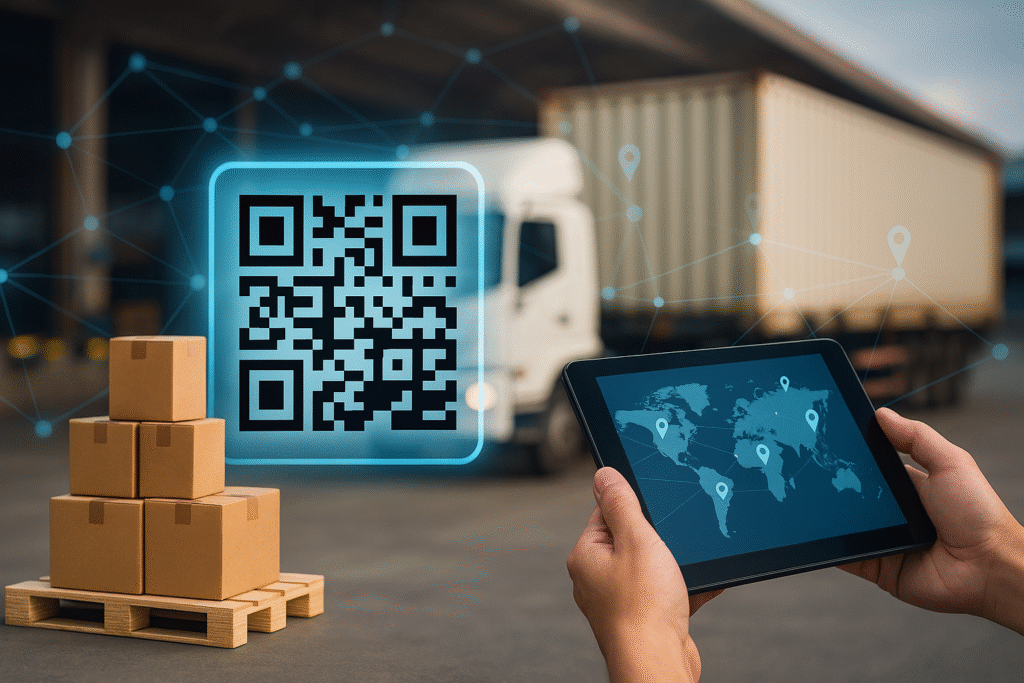
Over the last few years, the logistics and supply chain world has changed dramatically. What used to be a behind-the-scenes operation has become a frontline function expected to deliver faster, more transparently, and with fewer errors.
As expectations rise, businesses are turning to tools that make life easier and workflows smarter. One of the simplest, yet most powerful tools gaining ground is QR code traceability.
In this post, we’ll break down how QR code tracking works in logistics and supply chain management, why it matters in 2025, and how companies (including yours) can put it to real use, not just for visibility, but for better decision-making and efficiency.
What is QR Code Traceability and Why It Essential in 2025?
QR code traceability is about attaching a unique QR code to products, containers, or batches, and using it to track where those items are, where they’ve been, and who handled them. This matters more than ever today. Whether you’re shipping electronics, food, or pharma products, being able to answer basic questions like “Where is this now?” or “Who packed this item?” isn’t just nice to have it’s necessary.
With a QR tracking code, teams can scan and log items at every step: receiving, storing, picking, packing, shipping, and even delivery. It’s one of the easiest ways to implement real-time supply chain tracking without heavy tech investment.
How QR Codes Work in Logistics and Supply Chain Operations
You start by generating a QR code either manually or through a QR code generator with tracking built into your software. Each code carries relevant data: product ID, batch info, location, or a URL linking to its records.
Once that QR code is attached to a product or package, it travels with it through every handoff and checkpoint. Every scan updates the system. With the right QR code tracking software, your team can check the status or trace movement in seconds. This is what powers QR code product tracking, not just where something is, but what happened to it.
Top Benefits of QR Code Traceability for Logistics and Supply Chain Teams
So why are companies switching?
- Live tracking: Know where your shipments are in real time
- Fewer errors: Every scan creates a record — no more forgotten handoffs
- Quick audits: Pull full histories when a customer asks questions
- Simple training: Most teams already know how to use smartphones — no need for specialized scanners
- Return management: Easier to verify what’s coming back and why
When paired with a solid QR code-based inventory system, your whole operation becomes more responsive and less reactive.
Real-World Applications: QR Code Traceability Across Logistics Touchpoints
QR codes are flexible. You can use them:
- On pallets in the warehouse
- On cartons leaving your factory
- On return labels for customers
- On parts or components for QR code production tracking
Everywhere you apply a code, you add traceability and reduce risk.
In one example, a third-party logistics (3PL) firm we worked with at YNV Technologies used QR codes to connect incoming deliveries with outbound shipments. What used to take 15–20 minutes to verify now takes 3–4 minutes with a quick scan. No more clipboard chaos.
Latest Trends in QR Code Use Across the Supply Chain (2025)
QR code technology is getting smarter. We’re seeing:
- QR + IoT: Some teams pair QR with temperature or shock sensors. The QR logs handle data, while IoT adds environmental data.
- Blockchain-backed tracking: Not just where the item is, but proof it hasn’t been tampered with
- Dynamic QR codes: Update the data without printing a new label — great for fast-moving products
- Customer engagement: Some companies let customers scan to see origin info, route history, or instructions
This kind of supply chain tracking technology isn’t the future — it’s already happening.
QR Code Production Tracking vs Traditional Methods
Let’s say you still use spreadsheets or manual logs for production. It works until it doesn’t. One missed entry, one wrong row — and you’re chasing down problems for hours. With QR code production tracking, each step is logged automatically. One scan at a workstation updates everything, what was done, when, and by whom. Compared to manual logs, QR tracking is faster, cleaner, and creates a reliable audit trail.
Logistics vs Supply Chain: Where Does Traceability Apply?
You’ve probably heard the terms used together, but they’re not the same.
- Logistics is about movement: trucks, warehouses, routes, handling
- Supply chain includes that, but also planning, sourcing, procurement, and vendor coordination
QR code traceability helps both.
In logistics, it gives delivery teams better control.
In the supply chain, it gives managers better visibility for planning and forecasting.
So yes, traceability supports smarter logistics & supply chain management not just operations, but strategy.
Why YNV Technologies is the Right Partner for QR Traceability Solutions
At YNV, we don’t just build software. We build working systems.
We help you:
- Create your QR tracking code flow
- Set up QR code tracking software
- Build a mobile dashboard for your team
- Integrate with your WMS, ERP, or shipping tools
Train your staff and support them post-launch
Whether you need inventory management using QR code, QR code production tracking, or a full traceability solution we’ve done it, and we can do it for you.
If you’re still relying on manual tracking or outdated tools, this is the sign you’ve been waiting for. Let’s build a smarter supply chain together one that works in real time, not after the fact.
Visit ynvtechnologies.com or drop us a message.
We’d love to show you what traceability can look like when it’s done right.

